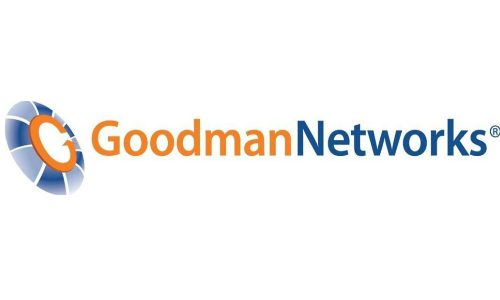Move over Geek Squad… there’s another national player in town targeting the entry-level “Do It For Me” market. Goodman Networks, a Frisco, Texas-based nationwide installer of network infrastructure and satellite systems with 2,000 technicians, has launched its smart home initiative across 130 markets nationwide. The program is targeting residential installations that will average $200 for various IoT devices, ranging from TV mounting to wireless home networks to audio systems.
Goodman Networks is a $950 million services company with a background rooted in building network infrastructure for commercial environments starting in 2000. From there, the company migrated to cell tower construction and satellite work. In 2019, Goodman conducted a five-market test for a major retailer in the residential space and quickly determined there is a market opportunity.
The new smart home program is aimed to support various manufacturers and retailers with a ready-made team of highly trained installation professionals, all of whom are vetted employees, not independent contractors. To run the program, Goodman named longtime integrator Daniel Pidgeon as president of home services in December 2019. Pidgeon ran Dallas-based integrator Starpower for decades before departing last year. He also held the position as chairman of the Consumer Technology Association (CTA), and is deeply connected with various trade and retail organizations.
“We are serving a place in our business model that is above do-it-yourself but also is not a profitable venture for classic custom integrators.”
Daniel Pidgeon, Goodman Networks
“We are not selling any product. We are supporting the brands that are selling the product.Our role is in the installation world,” says Pidgeon in an exclusive interview with CE Pro. “Our average installation would be somewhere in the $300 to $400 range, but that includes commercial and residential. Residential alone might be $150 or $200.”
Pidgeon says Goodman aims to fill the huge gap that currently exists between the DIY market and the custom installation space.
“We are serving a place in our business model that is above do-it-yourself but also is not a profitable venture for classic custom integrators,” he says. “It is an under-served market, or even a completely unserved market, I would say, that is right now left to contractors, journeymen and unqualified, crowdsourced online people.”
Those less-qualified installers are staining the market, according to Pidgeon.
“It turns people off from the smart home, IoT or any sort of integrated products. It really gives our industry a bad name. They provide a poor customer experience that sours consumers on tech products, which ultimately sours them on high-end products. This is an opportunity for Goodman to pick up the ball,” he says.
Pidgeon says Goodman will bring its history of performing at a high level to the IoT market.

“It has to do with consistency and the fact that there’s a culture here that is dedicated to premium delivery,” he notes. Pidgeon says it all starts with a detailed screening process during hiring, and an emphasis on technical skills.
“Goodman has a history of precision focus from the telecom world. In telecom, everything has to be installed with precision. There is no margin for technicians to do it their own way. They have to follow an exact procedure. That brings consistency to the project.”
He continues, “That’s why we have an excited group here at Goodman because we are now expanding beyond our traditional roots of telephony, networking and satellite into this huge, wide-open IoT space that seems to have been abandoned by everyone else.”
Pidgeon says the DIFM market is not profitable enough for custom integrators and the consumer brands don’t have the infrastructure or desire to enter a customer’s home.
Filling Gap Between DIY and Custom
“This leaves a really nice high-volume space that our company can manage and give a real high-quality experience to the end customer,” he adds.
So what happens when Goodman Networks’ technicians run into a client who wants more technology in their home? Pidgeon left the door open that the company could partner with a particular buying group.
“I think that would be smart, but I don’t think it makes sense for us to try to set up relationships local market by local market because we operate in massive volumes. We would have to have a partner that can handle massive volume for this to make sense financially,” he says.
Product-wise, Pidgeon says the company’s sweet spot will be in audio, video, security video surveillance and networking, but there are no categories of equipment that are necessarily off the table.
In terms of brand partnerships, Goodman Networks will be seeking out national retailers or OEM manufacturers looking for an installation arm. Technicians would be visible under the particular brand’s name, as if it was one of their own technicians arriving to do the install.
“We won’t hide the Goodman brand, but our first mission is to promote the brand partner. The interactions with the consumer will be on a white-label basis. If the brand partner wants its name visible, it would have to go through the expense of branding our vehicles with their own brand name. We already do that for several of our brand partners,” he notes.
Executive chairman and CEO John Goodman notes, “Following a successful partnership with one of the largest and most successful e-commerce companies in the world, we recognized an immense void that exists between tech promises and tech realities. Technology, particularly in our homes, is getting increasingly more sophisticated, while tech installations are increasingly left to a low-cost option that rarely delivers on consumer expectations. As a result, “the last 50” (or finishing touches of complex installation processes) can seriously impact the brand’s relationship with the consumer.
“Our 2,000+ W2 employee workforce is particularly suited to offer a premium installation solution at large-scale, helping brands to marry their quality products with a premium experience. Goodman’s successful and disciplined approach to the telecom industry transfers well to this need in the consumer technology industry, enabling Goodman Networks to expand its telecom service work while simultaneously moving into the consumer technology market. The combination of Goodman Networks’ past experience and ongoing goal of helping brands showcase the value of their products led us to bringing an industry leader like Daniel Pidgeon to lead this effort.”







